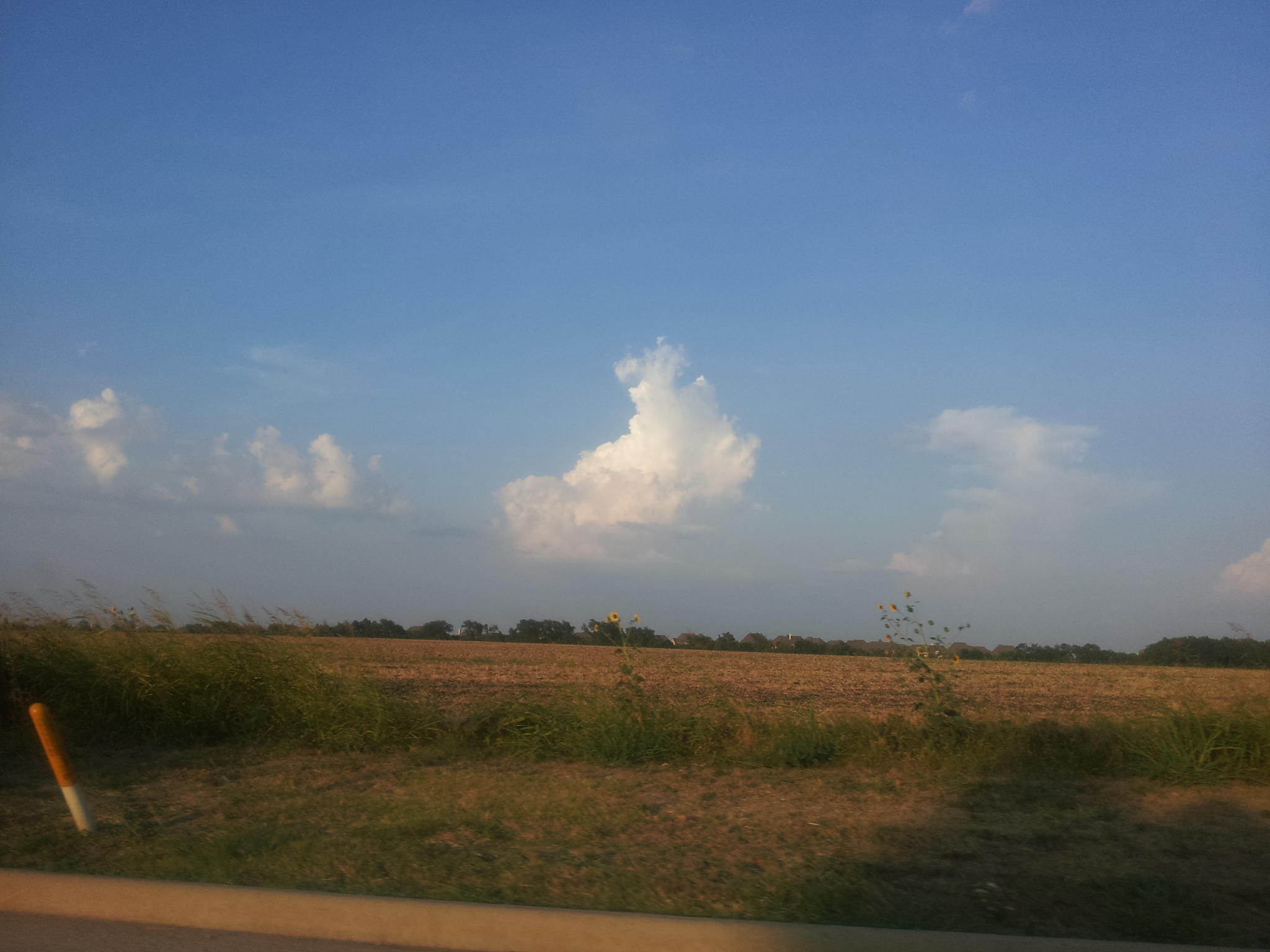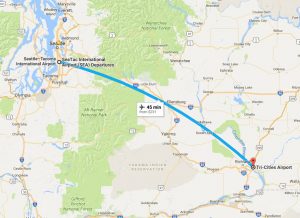
This was quite a week! After last week’s near-exhausting onslaught of post-CERN jet lag and my student, J’s, PhD thesis defense (as well as a number of home repair and other such chores), this week I had something of a break to look forward to. Jodi and I are both on approved leaves from teaching this semester, and so we are spending a lot of time in the field – at laboratories and other institutions where our research is ongoing. I’ve been bouncing between SMU, CERN, and Argonne National Laboratory. Jodi is currently at about the mid-point of a 5-week visit to the Pacific Northwest National Laboratory in Richland, WA. I traveled here this week to visit her and spend some time relaxing a bit before I hit the road again for Argonne this week.
Making the trip
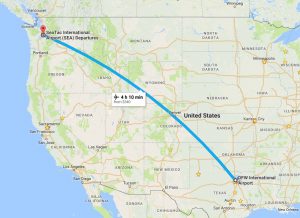
Prior to this week, I have seen Jodi for a grand total of about 18 hours in the past four weeks. I had been at CERN and when I returned I took Jodi to the airport to fly to PNNL the very next morning. So you can imagine how excited I was to be getting on a plane to travel to Seattle and then on to Pasco, WA to visit her this past week! It’s about a 4 hour flight from Dallas to Seattle and a 30-minute flight from there to Pasco, so overall it’s a pretty easy trip (apart from the 2 timezone changes you have to endure in the process, which becomes mildly irritating on the way home).
I landed in Pasco on Wednesday night, relieved to finally be back together (if only briefly) with Jodi.
A run on the Columbia
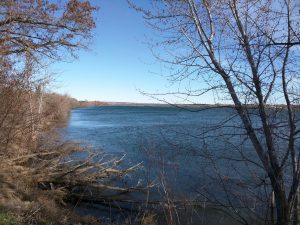
The Columbia river cuts through the entire region, a big, wide, beautiful blue river winding its way through a haunting landscape. The area is home to a large network of walking and biking trails that loop and spur in various places. One of them ran right past Jodi’s long-stay hotel, so I took the opportunity on Thursday to go for a run by the Columbia. Running north toward where PNNL is located, I enjoyed the cries of seabirds overhead, the views of orchards and woods and homes lining the far bank of the river, and the soothing overcast and drizzle the region can offer. It was wonderful. This was a very pleasant mental break from the “go go go” of the past two months.
Badger Mountain and LIGO

Jodi is working at PNNL, but since it would be too hard for me to access the building she works in due to the necessary safety and security requirements of the facility, we opted to just stay out of PNNL while I was visiting. On Friday, we drove the Badger Mountain in South Richland and hiked up the mountain. It’s an easy hike, and the payoff is a spectacular view of the surrounding landscape including the many orchards, vineyards, cities, mountains, and open plains.
The day was windy. According to locals, it was not the windiest they’ve ever seen. For Jodi and me, the steady intense blowing from the south was a bit harrowing on narrow mountain trains and switchbacks, bucking you a little every time you picked up a foot to step. But despite the constant gale, the day was bright and pleasant and the views unmatched. We enjoyed a few hours of hiking before returning down the mountain and back to the hotel.
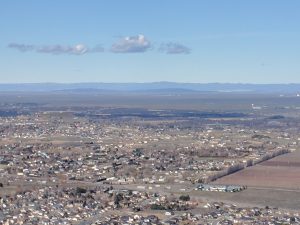
When we reached the peak, I spent a bit of time seeing if I could spot the Hanford LIGO site in the distant. Indeed, after consulting a map I confirmed that the white lines punctuated by white buildings, seen in the photo right in the middle-distance, was in fact the LIGO instrument. This is one of two twin laser interferometers (the other is in Lousiana) that last year heard the crash of black hole pairs rippling in spacetime. This site is now one of only a handful of such instruments on the planet, the vanguard of a new form of astronomy that will open our ears to the shuddering of the cosmic stage on which giants play unseen by the eye.
Time together
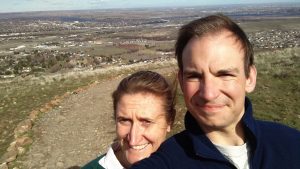 Mostly, this was about having some time together during a semester when we are mostly apart. Those of you reading this who are part of a couple where both are committed to their careers knows the strain that puts on personal time. Weekends don’t mean anything when you’re spending them apart, with only one or neither person at home. Weekdays might become 12 or 16-hour work days, just to take your mind off of being apart. Such is it with me and Jodi. Going to Richland was a nice way to capture a few days of time together before returning to the busy “apartness” we otherwise have to endure this semester.
Mostly, this was about having some time together during a semester when we are mostly apart. Those of you reading this who are part of a couple where both are committed to their careers knows the strain that puts on personal time. Weekends don’t mean anything when you’re spending them apart, with only one or neither person at home. Weekdays might become 12 or 16-hour work days, just to take your mind off of being apart. Such is it with me and Jodi. Going to Richland was a nice way to capture a few days of time together before returning to the busy “apartness” we otherwise have to endure this semester.
Going home
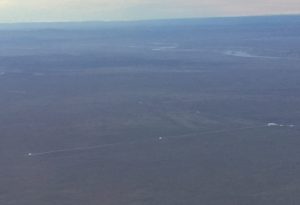
All good things come to an end. Jodi dropped me off this morning at the Tri-Cities airport for a 9:25am flight to Seattle. I found myself watching the landscape as the twin-rotor plane took off an headed west. We flew over LIGO, which afforded an opportunity to get a good aerial look at this incredible device. Its twin arms were fully visible, along with the buildings that punctuate its length (and were more easily visible in the photo from Badger Mountain). I was elated to get a good view of this spacetime telescope.
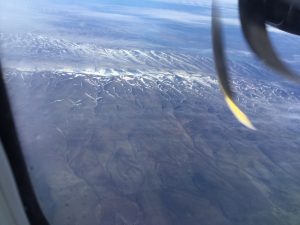
The landscape in this part of the world is a bit haunting. The land bears the scars of snow and snow-melt, the retreat of glaciers after the last ice age, and the rippling of the earth’s crust due to the tectonic activity common in this part of the United States. There is beauty. This is a window on geological variability that is usually hidden from human sight, our lives too short to experience the changes of the earth that it, by itself, is steadily capable of… and also the changes we have wrought on the earth in this, the Anthropocene Age. We humans have left our mark on the air, sea, and land, no differently have snow-melt, glacial retreat, and tectonic shifting of the crust. Sometimes you have to step back to appreciate what a fragile little ball this is, and how easily a determined species can reshape the skin of this planet.


